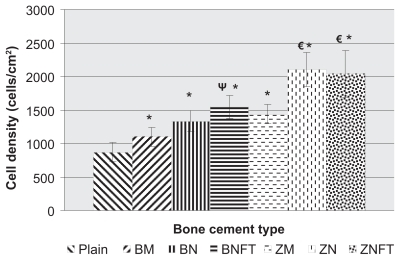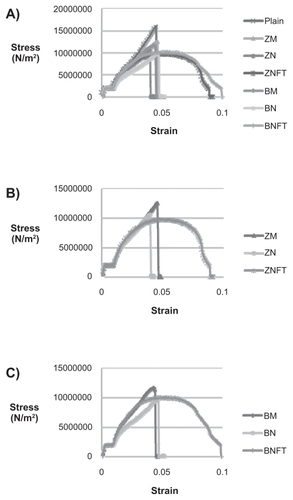Figures & data
Figure 1 SE M images of bone cements used in cytocompatibility testing [Left: 15K X (scale bar = 1 μm), Right: 50K X (scale bar = 100 nm)]: Plain (A, B), ZM (containing micron particulate ZrO2) (C, D), ZN (containing unfunctionalized ZrO2 nano-particles) (E, F), ZNFT (containing functionalized ZrO2 nano-particles) (G, H), BM (containing micron particulate BaSO4) (I, J), BN (containing unfunctionalized BaSO4 nano-particles) (K, L), and BNFT (containing functionalized BaSO4 nano-particles) (M, N).
![Figure 1 SE M images of bone cements used in cytocompatibility testing [Left: 15K X (scale bar = 1 μm), Right: 50K X (scale bar = 100 nm)]: Plain (A, B), ZM (containing micron particulate ZrO2) (C, D), ZN (containing unfunctionalized ZrO2 nano-particles) (E, F), ZNFT (containing functionalized ZrO2 nano-particles) (G, H), BM (containing micron particulate BaSO4) (I, J), BN (containing unfunctionalized BaSO4 nano-particles) (K, L), and BNFT (containing functionalized BaSO4 nano-particles) (M, N).](/cms/asset/9d0bfcac-6f3a-46ff-b8aa-a188a7870a6d/dijn_a_12184832_f0001_b.jpg)
Figure 2 Osteoblast cell density, after 4 hours, as a function of bone cement type. Data = mean +/− SEM; N = 3. Plain = Unmodified bone cements; BM = Bone cements with micron particulate BaSO4, BN = Bone cements with unfunctionalized BaSO4 nanoparticles, BNFT = Bone cements with functionalized BaSO4 nanoparticles; ZM = Bone cements with micron particulate ZrO2, ZN = Bone cements with unfunctionalized ZrO2 nanoparticles; ZNFT = Bone cements with functionalized ZrO2 nanoparticles. *Compared to plain bone cement; adhesion on bone cements containing the following ceramic particles was found to be greater: micron particulate BaSO4 (p < 0.05), unfunctionalized BaSO4 nano-particles (p < 0.05), and BaSO4 nano-particles functionalized with TMS (p < 0.005).

Figure 3 Osteoblast cell-density, after 24 hours, as a function of bone cement type. Data = mean +/− SEM; N = 3. Plain = Unmodified bone cements, BM = Bone cements with micron particulate BaSO4, BN = Bone cements with unfunctionalized BaSO4 nanoparticles, BNFT = Bone cements with functionalized BaSO4 nanoparticles, ZM = Bone cements with micron particulate ZrO2, ZN = Bone cements with unfunctionalized ZrO2 nanoparticles, ZNFT = Bone cements with functionalized ZrO2 nanoparticles. *Compared to plain bone cement, adhesion on bone cements containing all ceramic particles was found to be greater: micron particulate BaSO4 (p < 0.1), unfunctionalized BaSO4 nano-particles (p < 0.005), ZrO2 nano-particles functionalized with TMS (p < 0.005), BaSO4 nano-particles functionalized with TMS (p < 0.001), micron ZrO2 particles (p < 0.001), and unfunctionalized ZrO2 nano-particles (p < 0.001). ΨCompared to bone cements containing micron BaSO4 particles, adhesion was found to be greater on bone cements containing BaSO4 nano-particles functionalized with TMS (p < 0.05). €WRT bone cements containing micron ZrO2 particles, adhesion was found to be greater on bone cements containing unfunctionalized ZrO2 nano-particles (p < 0.05) and ZrO2 nano-particles functionalized with TMS (p < 0.1).

Figure 4 Fluorescence microscopy images (magnification = 10X) of osteoblasts after 4 hours of adhesion on different bone cements: A) Plain, B) ZM (containing micron particulate ZrO2), C) ZN (containing unfunctionalized ZrO2 nano-particles), D) ZNFT (containing ZrO2 nano-particles functionalized with TMS, E) BM (containing micron particulate BaSO4), F) BN (containing unfunctionalized BaSO4 nano-additives), and G) BNFT (containing BaSO4 nano-additives functionalized with TMS).

Figure 5 Fluorescence microscopy images (magnification = 10X) of osteoblasts after 24 hours of proliferation on different bone cements: A) Plain, B) ZM (containing micron particulate ZrO2), C) ZN (containing unfunctionalized ZrO2 nano-particles), D) ZNFT (containing ZrO2 nano-particles functionalized with TMS, E) BM (containing micron particulate BaSO4), F) BN (containing unfunctionalized BaSO4 nano-additives), and G) BNFT (containing BaSO4 nano-additives functionalized with TMS).

Figure 6 Representative tensile stress-strain curves for various bone cements. One representative of three trials is shown for each bone cement. Bone cements tested included: Plain, ZM (containing micron particulate ZrO2), ZN (containing unfunctionalized ZrO2 nano-particles), ZNFT (containing functionalized ZrO2 nano-particles), BM (containing micron particulate BaSO4), BN (containing unfunctionalized BaSO4 nano-particles), and BNFT (containing functionalized BaSO4 nano-particles). A) All bone cements, B) Bone cements containing ZrO2 particles, and C) Bone cements containing BaSO4 particles.

Figure 7 Representative compressive stress-strain curves for various bone cements. One representative of three trials is shown for each bone cement. Bone cements tested included: Plain, ZM (containing micron particulate ZrO2), ZN (containing unfunctionalized ZrO2 nano-particles), ZNFT (containing functionalized ZrO2 nano-particles), BM (containing micron particulate BaSO4), BN (containing unfunctionalized BaSO4 nano-particles), and BNFT (containing functionalized BaSO4 nano-particles). A) All bone cements, B) Bone cements containing ZrO2 particles, and C) Bone cements containing BaSO4 particles.

Table 1 Maximum stresses and Young’s moduli of various bone cements under tension: Plain, ZM (containing micron particulate ZrO2), ZN (containing unfunctionalized ZrO2 nano-particles), ZNFT (containing functionalized ZrO2 nano-particles), BM (containing micron particulate BaSO4), BN (containing unfunctionalized BaSO4 nano-particles), and BNFT (containing functionalized BaSO4 nano-particles). Young’s moduli values for bone obtained from study by Mente et al
Figure 8 SE M images of bone cements fractured in tension [Left: 5K X (scale bar = 3 μm), Right: 15K X (scale bar = 1 μm)]: Plain (A, B), ZM (containing micron particulate ZrO2) (C, D), ZN (containing unfunctionalized ZrO2 nano-particles) (E, F), ZNFT (containing functionalized ZrO2 nano-particles) (G, H), BM (containing micron particulate BaSO4) (I, J), BN (containing unfunctionalized BaSO4 nano-particles) (K, L), and BNFT (containing functionalized BaSO4 nano-particles) (M, N).
![Figure 8 SE M images of bone cements fractured in tension [Left: 5K X (scale bar = 3 μm), Right: 15K X (scale bar = 1 μm)]: Plain (A, B), ZM (containing micron particulate ZrO2) (C, D), ZN (containing unfunctionalized ZrO2 nano-particles) (E, F), ZNFT (containing functionalized ZrO2 nano-particles) (G, H), BM (containing micron particulate BaSO4) (I, J), BN (containing unfunctionalized BaSO4 nano-particles) (K, L), and BNFT (containing functionalized BaSO4 nano-particles) (M, N).](/cms/asset/d3cb334d-cd4f-4e66-80f3-2e6254dd5c3b/dijn_a_12184832_f0008_b.jpg)
Table 2 Compressive stress required to obtain 56% strain (1 mm of compression) in various bone cements: Plain, ZM (containing micron particulate ZrO2), ZN (containing unfunctionalized ZrO2 nano-particles), ZNFT (containing functionalized ZrO2 nanoparticles), BM (containing micron particulate BaSO4), BN (containing unfunctionalized BaSO4 nano-particles), and BNFT (containing functionalized BaSO4 nano-particles). Maximum compressive stress at 56% strain for bone calculated from Young’s moduli values obtained from study by Mente et al
Table 3 Radio-opacity, as indicated by mean gray value, of various bone cements. Higher mean gray value is indicative of a greater degree of radio-opacity. Bone cements analyzed included: Plain, ZM (containing micron particulate ZrO2), ZN (containing unfunctionalized ZrO2 nano-particles), ZNFT (containing functionalized ZrO2 nano-particles), BM (containing micron particulate BaSO4), BN (containing unfunctionalized BaSO4 nano-particles), and BNFT (containing functionalized BaSO4 nano-particles)